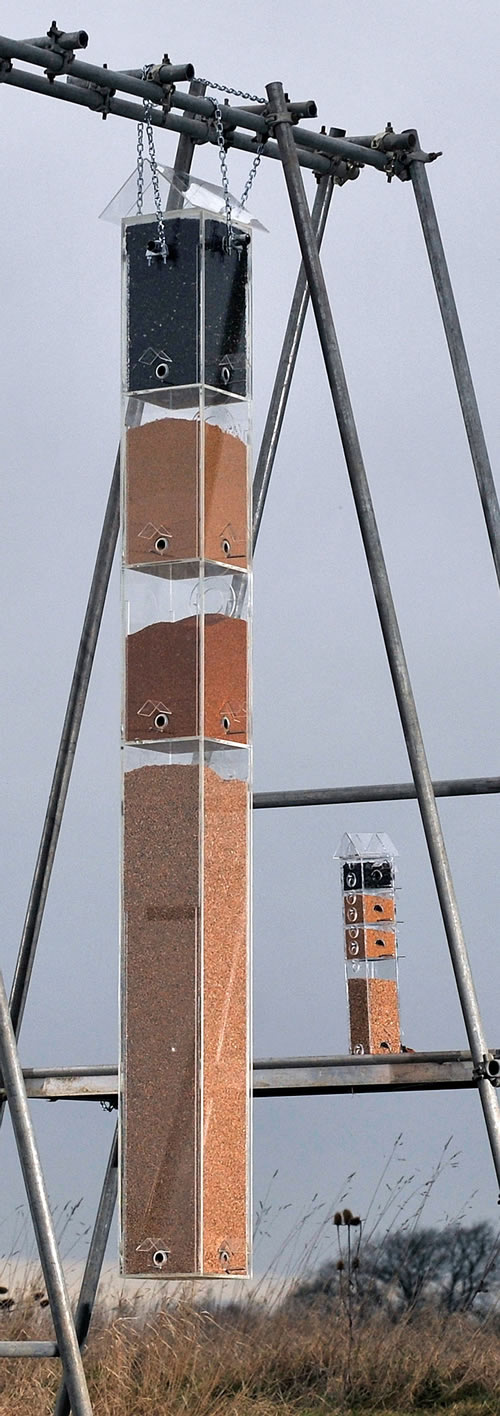
This has been the coldest winter for nearly two decades, and many farmland birds will have struggled to find seed food at this critical time of year. However, on the Game & Wildlife Conservation Trust’s research farm in Leicestershire, which is using pioneering game management techniques to reverse the decline of threatened wildlife, farmland birds have benefitted from a record-breaking bird feeder. The specially designed bird feeder weighs in at a massive quarter of a tonne (254 kilos) when filled with farmland bird favourites such as wheat, mustard seeds, sunflower seeds and red millet.
This Guinness World Record™ attempt at creating the world’s biggest bird feeder by volume of food is supported by Natural England, the government’s wildlife advisor, Yara Ltd, who have been involved in the Trust’s game crop trials, and Belmont Seeds. The aim of this record attempt is to raise awareness of the increased problems faced by farmland birds, especially at this time of year when the ’hungry gap’ from February until late spring, means that many birds struggle to survive through this difficult period.
Farmland bird numbers have halved since the 1970s and many of our once familiar farmland birds, such as the tree sparrow, grey partridge and corn bunting have suffered even more severe declines. The Trust believes that the loss of set-aside, and the increased demand for food production could mean that the situation may deteriorate even further for many threatened farmland bird species.
The need to provide farmland birds with food until late spring either by growing wild bird crops or feeding from wheat hoppers is paramount, especially as birds need to build up their energy reserves for breeding.
Dr Alastair Leake, head of the Game & Wildlife Trust’s Allerton Project farm in Leicestershire said, "The need to make space for wildlife has never been so pressing and it is critical that we support our farmers to do this. If we don’t then we run the risk of losing some of our important farmland birds that are already teetering on the edge."
Dr Chris Stoate, head of research at the Trust’s Allerton Project was instrumental in the design of wild bird crops said, "Songbirds at Loddington have benefited from both wild bird crops and the provision of grain in pheasant hoppers through the winter. In the critical late winter period, bird numbers were two and a half times higher in years with feeding than in years without it."
Natural England is currently targeting conservation efforts to help the plight of our farmland birds, by offering farmers up to £350 per hectare per year for improving habitats and growing wild bird crops through one of its green farming schemes. In two pilot areas, the Lincolnshire fens and Sherwood in Nottinghamshire, Natural England is hoping to double the number of farmers who sign up to the schemes, specifically to increase farmland bird habitat in intensively farmed arable areas.
Dr Helen Phillips, Chief Executive of Natural England, said: "Many of our farmland birds have suffered huge declines over recent decades. We are delighted to support this record attempt as it helps to raise awareness of the plight of farmland birds and the critical role that land managers can play in their survival. Our green farming schemes - targeted at those species which we know are declining in certain areas - create opportunities for more farmers to be directly involved with conservation."
The Game & Wildlife Conservation Trust’s Guinness World Record attempt is supported by Yara UK Ltd, Natural England and Belmont Seeds.
PHOTOCAPTION: The Game & Wildlife Conservation Trust recently attempted a Guinness Word Record™ at creating the world’s biggest bird feeder by volume of food. The bird feeder, which in total weighs 254 kilos, is filled with 13k of sunflower seeds, 18k mustard seed, 15k red millet and 51k of wheat and is sited on the Trust’s Allerton Project farm at Loddington in Leicestershire.
